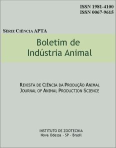Production and management of elephant grass cv. Napier
Abstract
The regrowth of cuttings imposed on a elephant grass stand during the end of the rainy season (2-28, 3-21, 4-11 and 5-2) were evaluated at 28-day intervals during the dry-season (6-18, 7-16, 8-14 and 9-12), during two years at the €œEstação Experimental de Nova Odessa, E. S. Paulo€. During the dry-season the 2-28, 3-21, 4-11 and 5-2 regrowth (average of the 4 cuttings during the dry-season) yielded, respectively: 2,303, 1,005, 366 and 358 ± 61 kg of DM/ha (2-28 > 3-21 > 4-11 = 5-2, P < 0.05); presented. respectively: 5.9; 8.3; 11.0 and 12.2 ± 0.9% CP (2-28 3-21 < 5-2, 2-28 < 4-11, P < 0.05) and 34.0; 31.8; 29.5 and 28.3 ± 0.3% CF (2-28 > 3-21 > 4-11 > 5-2, P < 0.05). The height of the elephant grass stand was measured at each cutting and related with the dry matter production. It was found out that the dry matter production expressed in kg/ha (Y) is related to the height of the elephant grass stand expressed in centimeters by the following equation: log Y = 1.69865 log X €” 0.05435, s = ± 0.07197 and r2 = 0.9673.Downloads
Downloads
Published
Issue
Section
License
Os autores não serão remunerados pela publicação de trabalhos, pois devem abrir mão de seus direitos autorais em favor deste periódico. Por outro lado, os autores ficam autorizados a publicar seus artigos, simultaneamente, em repositórios da instituição de sua origem, desde que citada a fonte da publicação original seja Boletim de Indústria Animal. A revista se reserva o direito de efetuar, nos originais, alterações de ordem normativa, ortográfica e gramatical, com vistas a manter o padrão culto da língua e a credibilidade do veículo. Respeitará, no entanto, o estilo de escrever dos autores. Alterações, correções ou sugestões de ordem conceitual serão encaminhadas aos autores, quando necessário. Nesses casos, os artigos, depois de adequados, deverão ser submetidos a nova apreciação. As opiniões emitidas pelos autores dos artigos são de sua exclusiva responsabilidade. Todo o conteúdo deste periódico, exceto onde está identificado, está licenciado sob a Licença Creative Commons Attribution (CC-BY-NC). A condição BY implica que os licenciados podem copiar, distribuir, exibir e executar a obra e fazer trabalhos derivados com base em que só se dão o autor ou licenciante os créditos na forma especificada por estes. A cláusula NC significa que os licenciados podem copiar, distribuir, exibir e executar a obra e fazer trabalhos derivados com base apenas para fins não comerciais.













